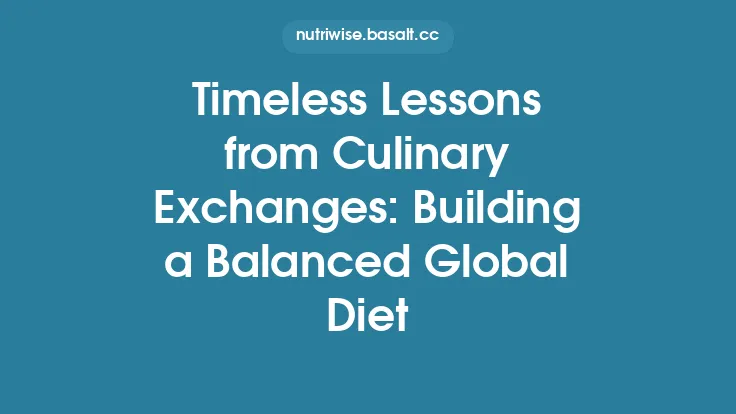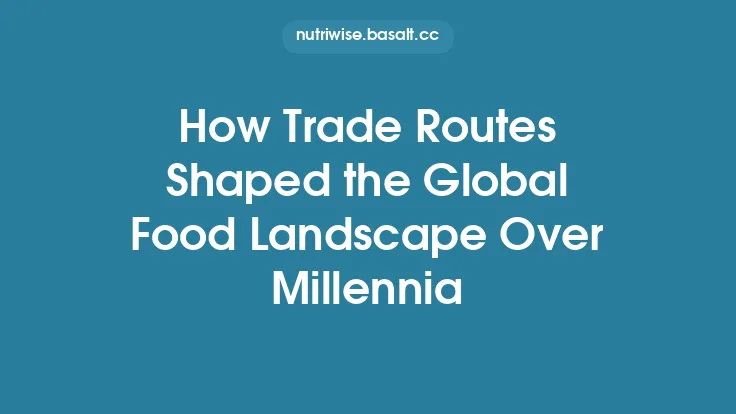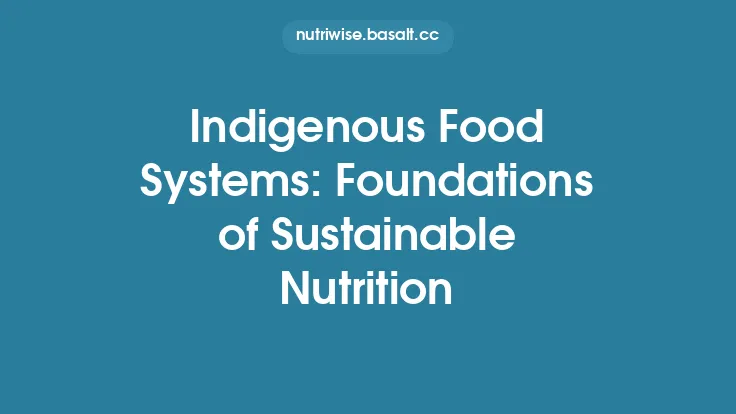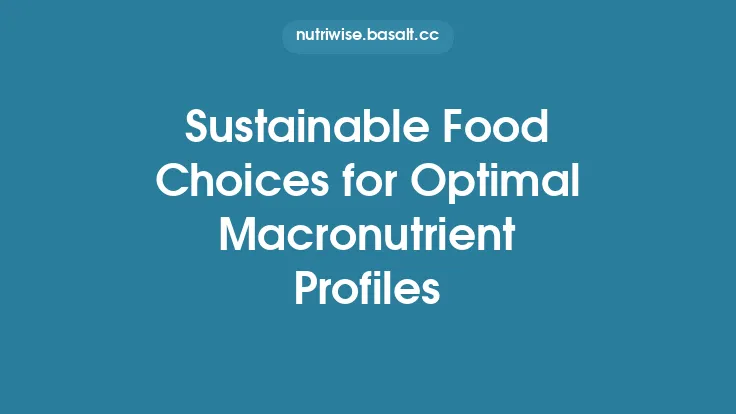The movement of people, ideas, and flavors across borders has always been a catalyst for change in the kitchen, but in recent decades it has also become a powerful engine for sustainability. When culinary traditions intersect, they do more than create new taste experiences; they generate fresh perspectives on how food is grown, processed, distributed, and consumed. These cross‑cultural exchanges inspire practices that reduce environmental impact, preserve biodiversity, and empower communities to manage their own food systems. By examining the mechanisms through which global culinary dialogue translates into sustainable outcomes, we can identify actionable pathways for a resilient food future.
Seed and Crop Diversity Through Culinary Exchange
One of the most tangible sustainability benefits of cross‑cultural food interactions is the enrichment of agricultural biodiversity. When a cuisine adopts a foreign staple—such as quinoa from the Andes, millets from South Asia, or teff from Ethiopia—farmers are prompted to experiment with new varieties that often possess unique agronomic traits. These traits include drought tolerance, pest resistance, and adaptability to marginal soils, which are increasingly valuable in the face of climate volatility.
- Participatory Plant Breeding: Community groups and NGOs facilitate farmer‑to‑farmer seed swaps, allowing cultivators to select and propagate varieties that perform well under local conditions while retaining the culinary qualities prized by the adopting culture. This participatory approach preserves genetic heterogeneity and reduces reliance on a narrow set of commercial hybrids.
- Conservation of Heirloom Varieties: Culinary curiosity drives demand for heritage grains and legumes that might otherwise disappear. Restaurants and home cooks seeking authentic flavors often source heirloom seeds, creating market incentives for their cultivation and safeguarding them from genetic erosion.
- Agroecological Integration: Introducing a new crop can diversify cropping systems, breaking pest cycles and improving soil health through complementary root structures and nutrient uptake patterns. For example, the integration of African leafy greens like amaranth into Southeast Asian vegetable gardens introduces deep‑rooted species that enhance soil organic matter and reduce the need for synthetic fertilizers.
Sustainable Protein Shifts Prompted by Global Palates
The global appetite for plant‑based proteins has been amplified by the diffusion of culinary traditions that historically rely on legumes, nuts, and fermented soy products. These protein sources carry a markedly lower environmental footprint than conventional animal agriculture.
- Legume‑Centric Dishes: The popularity of dishes such as Indian dal, Mexican frijoles, and Ethiopian shiro has spurred increased legume production worldwide. Legumes fix atmospheric nitrogen, reducing the demand for synthetic nitrogen fertilizers, which are energy‑intensive to produce and contribute to greenhouse gas emissions.
- Fermentation as Preservation: Fermented foods—tempeh, miso, kimchi, and natto—extend shelf life without refrigeration, curbing food waste. The microbial processes also enhance digestibility and nutrient bioavailability, making plant proteins more nutritionally competitive with animal proteins.
- Nuts and Seeds in Snack Culture: The rise of Mediterranean-inspired snacking, featuring almonds, pistachios, and sesame seeds, encourages the cultivation of perennial tree crops that sequester carbon over long lifespans and require fewer inputs than annual grain crops.
Low‑Impact Cooking Techniques Shared Across Cultures
Culinary exchanges transmit not only ingredients but also cooking methods that can dramatically reduce energy consumption and waste.
- Steaming and Boiling: Asian cuisines have long championed steaming as a gentle, water‑efficient cooking method. When adopted in Western contexts, steaming reduces the need for high‑temperature ovens and minimizes nutrient loss, extending the usable life of produce.
- Open‑Fire and Clay Oven Cooking: Traditional tandoor, tandoori, and pit‑cooking techniques use residual heat and charcoal efficiently, often employing renewable biomass. Modern adaptations—such as solar‑powered earth ovens—draw on these age‑old practices to provide low‑carbon cooking options for remote or off‑grid communities.
- One‑Pot Meals: Mediterranean and Middle Eastern cuisines frequently employ one‑pot stews (e.g., tagine, paella) that consolidate cooking steps, reducing water usage for cleaning and limiting energy input. The concept has been embraced by contemporary “minimalist” cooking movements, reinforcing resource‑conserving habits.
Food Waste Reduction Through Cultural Practices
Every culture has developed strategies to minimize waste, and the cross‑pollination of these practices can amplify their impact.
- Utilization of By‑Products: Japanese cuisine’s use of fish bones for dashi broth, Mexican cuisine’s incorporation of corn husks in tamales, and Scandinavian traditions of pickling beet tops illustrate how by‑products become valued ingredients. When these techniques spread, they inspire chefs and home cooks to re‑evaluate waste streams in their own kitchens.
- Seasonal Preservation: The practice of fermenting, drying, and canning seasonal produce—common in Korean kimchi, German sauerkraut, and Indian pickles—extends the edible life of crops beyond harvest windows, reducing reliance on imported out‑of‑season produce that often carries a higher carbon footprint.
- Portion‑Based Cooking: The concept of “family‑style” sharing, prevalent in many African and Middle Eastern meals, encourages diners to serve themselves from communal platters, allowing for more accurate portion control and less plate waste.
Community‑Based Food Systems Inspired by Culinary Exchange
When communities adopt foreign culinary traditions, they often create localized food networks to support the new demand, fostering resilience and sustainability.
- Community‑Supported Agriculture (CSA) Models: The popularity of Mediterranean diets in North America has led to the formation of CSAs that specialize in olives, figs, and heritage tomatoes. Subscribers receive a seasonal box, aligning consumption with local harvest cycles and reducing transportation emissions.
- Urban Food Hubs: In cities where Asian street food has become a staple, urban farms have emerged to supply fresh herbs, microgreens, and specialty vegetables directly to vendors, shortening supply chains and providing fresh, low‑input produce to densely populated areas.
- Food Sovereignty Initiatives: Indigenous groups have leveraged the global interest in their traditional foods—such as wild rice, teff, and cassava—to negotiate fair trade agreements and protect intellectual property, ensuring that cultural exchange does not translate into exploitation but rather into equitable, sustainable development.
Policy Implications and International Collaboration
Sustainable practices born from culinary exchange do not exist in a vacuum; they are reinforced—or hindered—by policy frameworks.
- Trade Agreements that Favor Sustainable Crops: By incorporating sustainability criteria into tariff structures, governments can incentivize the import and export of low‑impact crops (e.g., legumes, ancient grains) while discouraging high‑emission commodities.
- Funding for Agro‑Culinary Research: Grants that support interdisciplinary research—combining agronomy, food science, and cultural studies—enable the systematic evaluation of how specific culinary practices affect resource use, greenhouse gas emissions, and biodiversity.
- Standardization of Food Labeling: Clear labeling of “heritage,” “organic,” and “low‑carbon” attributes helps consumers make informed choices that align with the sustainable practices they admire in foreign cuisines.
Education and Knowledge Transfer
The diffusion of sustainable culinary practices hinges on effective education at multiple levels.
- Culinary Schools as Hubs of Sustainability: Incorporating modules on global food systems, seed saving, and low‑impact cooking techniques equips future chefs with the tools to champion sustainability in professional kitchens.
- Public Cooking Workshops: Community centers that host cooking classes featuring dishes from different cultures also teach participants about the environmental rationale behind ingredient choices and preparation methods.
- Digital Platforms and Open‑Source Recipes: Online repositories that document traditional recipes alongside sustainability notes (e.g., “use locally available millet instead of imported quinoa”) democratize access to knowledge and encourage adaptive, context‑specific cooking.
Measuring Impact: Metrics for Sustainable Culinary Exchange
To ensure that cross‑cultural food practices translate into tangible environmental benefits, robust metrics are essential.
- Carbon Footprint of Ingredient Substitution: Life‑cycle assessment (LCA) tools can compare the greenhouse gas emissions of a traditional ingredient with its sustainable alternative introduced through culinary exchange.
- Biodiversity Indices: Tracking the number of cultivated varieties and the acreage devoted to underutilized crops provides a quantitative measure of genetic diversity preservation.
- Food Waste Audits: Monitoring waste streams before and after the adoption of waste‑reduction techniques (e.g., fermentation, whole‑plant utilization) offers concrete data on efficiency gains.
- Water Use Efficiency: Calculating the volume of water required per kilogram of produce for newly introduced crops versus conventional staples helps assess the water‑saving potential of culinary diversification.
Future Outlook: Scaling Sustainable Practices Through Global Gastronomy
The trajectory of global culinary exchange points toward an increasingly interconnected food culture where sustainability is a shared value rather than a niche concern. As travelers, migrants, and digital media continue to disseminate flavors and techniques, the opportunity to embed environmentally responsible practices into everyday meals expands. By intentionally aligning the excitement of new cuisines with the principles of ecological stewardship—through diversified crops, low‑impact cooking, waste minimization, community empowerment, supportive policies, and rigorous measurement—we can transform the global palate into a catalyst for a more sustainable food system.





